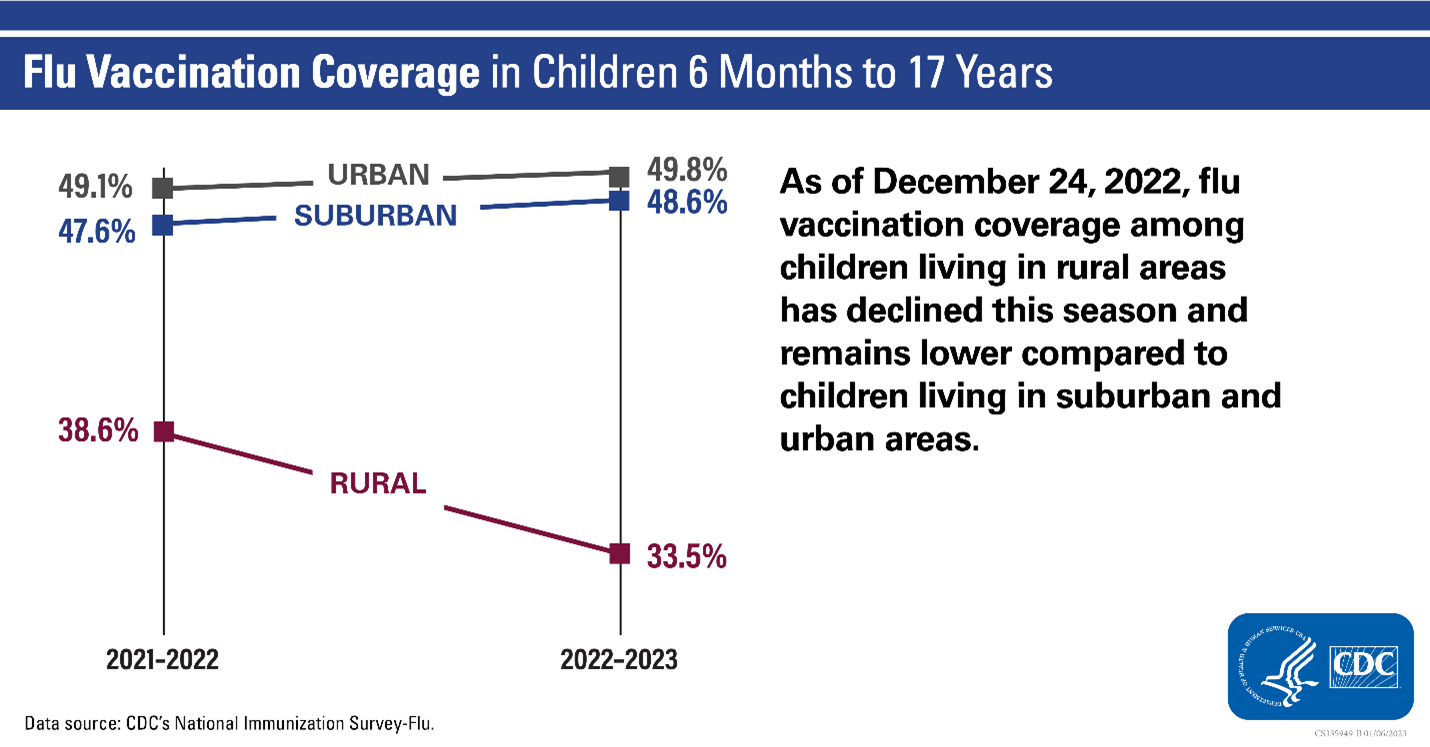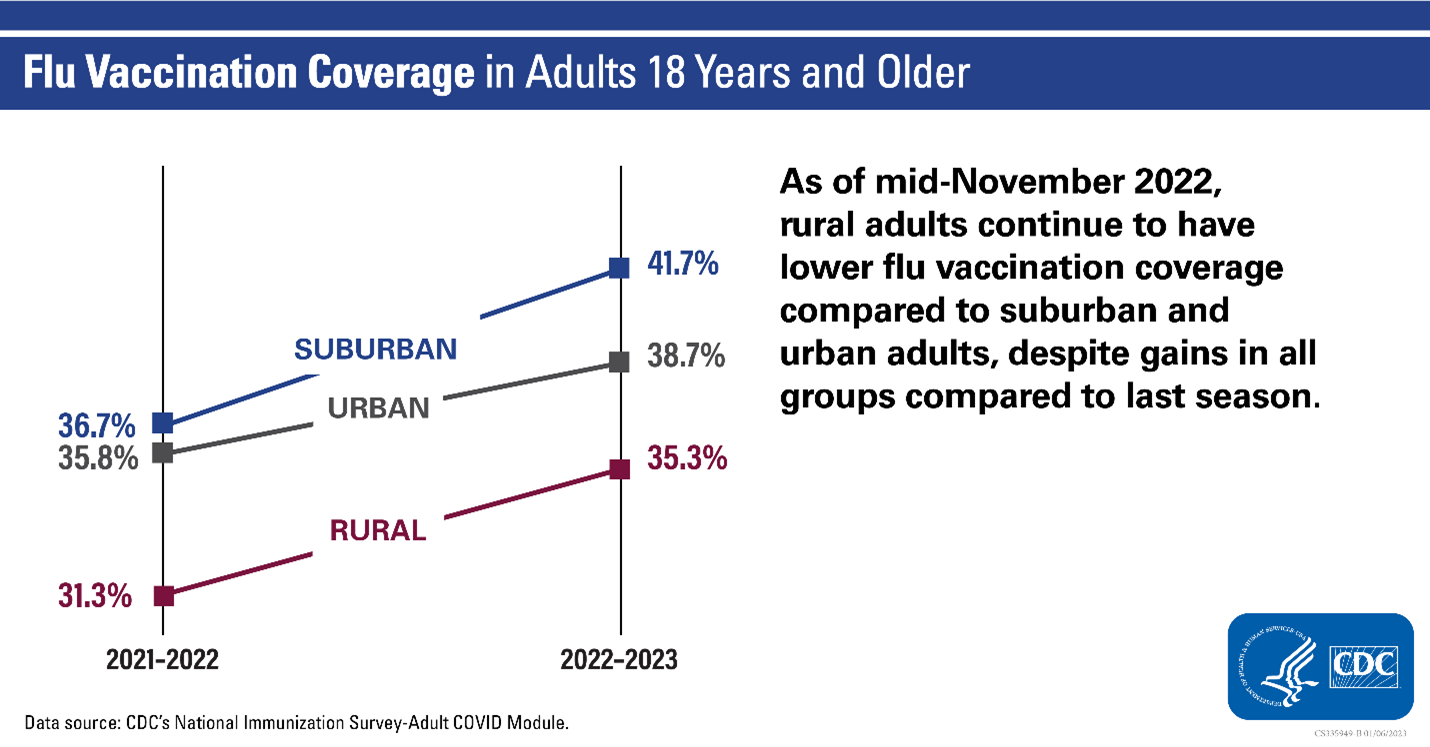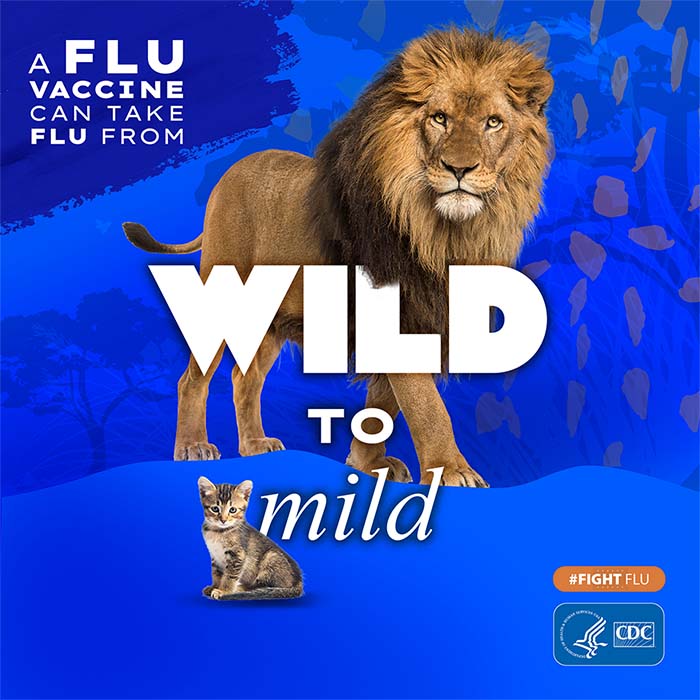Flu Vaccination Coverage Update
CDC continues to recommend vaccination as the flu season is ongoing
January 11, 2023—CDC’s latest flu vaccination coverage estimates were updated on January 6, 2023. Estimates show that a drop in flu vaccine uptake observed early this season among adults overall has narrowed as the season has progressed; however, coverage among pregnant women remains concerningly low. Estimates of coverage among children continue to be similar to those from last season overall with the exception of improvements in coverage seen among Hispanic children. Other data show racial and ethnic disparities persist among adults despite some improvements in coverage among Black adults and Asian American adults, and coverage in urban and suburban parts of the country continues to be higher than in rural areas. With the flu season ongoing in the U.S., CDC continues to recommend flu vaccination.
Pregnant Women
Flu vaccination coverage among pregnant women continues to be lower this season compared to recent prior seasons. Based on data from December 31, 2022, flu vaccination coverage among pregnant women as of the end of November 2022 is 11.8 percentage points lower compared to the end of November 2021 (43.5% compared with 55.3%) and 18.6 percentage points lower than at the end of November 2020 (43.5% compared with 62.1%). This is a dramatic setback in coverage among pregnant women. Declines in coverage among pregnant women were observed across all racial and ethnic groups, with the lowest coverage among non-Hispanic, Black pregnant women (25.7%). These drops in flu vaccination coverage among pregnant women, who are among those at higher risk of serious flu complications, are very concerning.
Children
Overall flu vaccination coverage among children this season as of December 24, 2022 (47.5%), is similar to coverage in December 2021 (47.2%); however, this season’s coverage among children so far is about 4 percentage points lower compared with the same time in December 2020 (51.7%).
By Race/Ethnicity: Flu vaccination coverage by race/ethnicity among children is similar to last season with the exception of among Hispanic children, where a 4.5 percentage point increase in coverage has been observed. This increase narrowed the disparity in coverage between non-Hispanic, White children (48.5%) and Hispanic children (47.8%). Non-Hispanic, Black children continue to have the lowest flu vaccination coverage (40.5%) among all racial and ethnic groups.
Adults
Claims data for adults vaccinated in pharmacies and medical offices early this season showed the number of flu vaccine doses given was down by 15 percent at the end of October, but this gap has been narrowing as vaccination has increased and more early claims have likely been captured. Claims data for adults as of December 17, 2022, suggest flu vaccination coverage may only be about 2 percent lower than the same time last season. Survey data from January 6, 2023 suggest flu vaccination coverage for adults this season is 4.1 percentage points higher compared to the same time last season. However, survey data may over-estimate coverage because self or parental reporting of flu vaccination status. Claims data, on the other hand, may underestimate the number of doses given since there are data reporting lags, and the claims do not capture all vaccination events like workplace vaccination.
By Race/Ethnicity: Data as of mid-November show flu vaccination coverage by race/ethnicity among adults is similar or higher among all racial and ethnic groups compared to the same time last season. So far this season, the greatest increase in flu vaccination coverage is among non-Hispanic, Asian adults (47.3%) with an increase of 7.8 percentage points, and the second largest increase is among non-Hispanic, Black adults (32.9%), with an increase of 5.0 percentage points compared with last season. However, disparities in flu vaccination coverage persist among adults in some racial and ethnic groups. Coverage for non-Hispanic, White adults (45.1%) is 12.2-26.1 percentage points higher compared to all other racial and ethnic groups except for non-Hispanic, Asian adults (47.3%), who have similar coverage.
Coverage by Location
Flu vaccination coverage differs based on where people live.
For children, as of December 24, 2022, coverage for children living in rural areas is 5.1 percentage points lower this season compared with their coverage at the same time last season (33.5% compared to 38.6%). This season, flu vaccination coverage among children living in rural areas (33.5%) is lower compared to children living in suburban and urban areas:
- 15.1 percentage points lower compared to children living in suburban areas (48.6%).
- 16.3 percentage points lower compared with children living in urban areas (49.8%).
Coverage so far this season for children living in suburban and urban areas is similar to their coverage at the same time last season.

For adults, as of mid-November 2022, flu vaccination coverage among states and DC ranges from 19.3% to 51.7%. While not as great a disparity as among children, adults living in rural areas also have lower flu vaccination coverage compared to adults in urban and suburban areas. Flu vaccination coverage among adults living in rural areas (35.3%) is:
- 6.4 percentage points lower compared with adults living in suburban areas (41.7%).
- 3.4 percentage points lower compared with adults living in urban areas (38.7).

Place of Vaccination
Based on combined claims data for the 2022-2023 season, for adults 18 years and older, an estimated 2.0 million more doses have been administered in pharmacies this season, compared with the same time in December 2021. For physician medical offices, an estimated 3.5 million fewer doses have been administered compared with the same time in December 2021. Data for vaccinations received at workplaces and other locations are not available.
Flu Activity Update
Although flu activity is declining in most areas, it remains elevated. This week’s FluView, week-ending December 31, 2022, reported almost 19,000 flu hospitalizations this week and another 13 flu-related pediatric deaths. This brings the total of flu pediatric deaths so far this season to 74. Similar to previous seasons, of the reported pediatric deaths that occurred in children who were eligible for vaccination and with a known vaccination status, approximately 80% were not vaccinated against flu this season.
Children younger than 5 years old—especially those younger than 2—and children of any age with certain chronic health conditions, are at higher risk of developing serious flu complications. Because these groups of children are at higher risk, it is especially important that they get a seasonal flu vaccine to reduce their risk from flu, including their risk of being hospitalized or dying from flu if they do get sick.
CDC recommends flu vaccination as long as flu viruses are spreading in the community. Everyone 6 months and older should get a flu vaccine each year for the best protection against flu. There’s still time to benefit from the protection vaccination offers this season as flu activity is ongoing.
